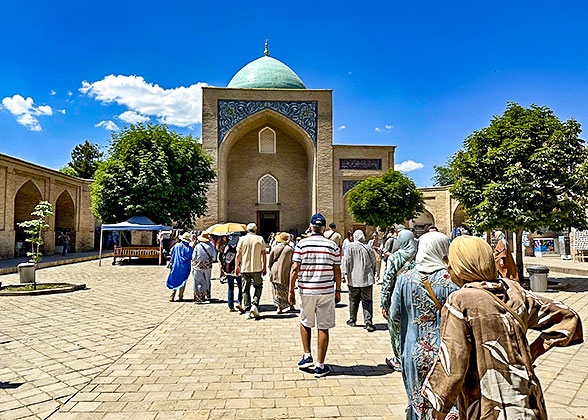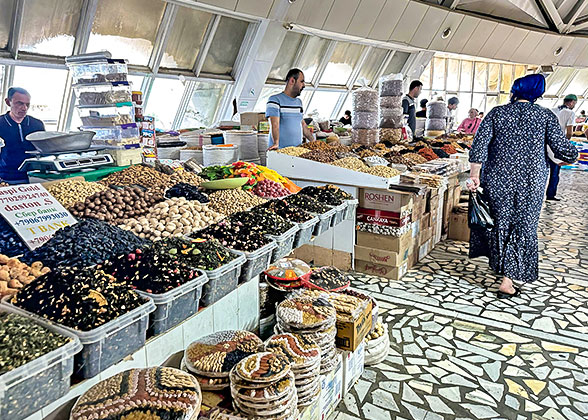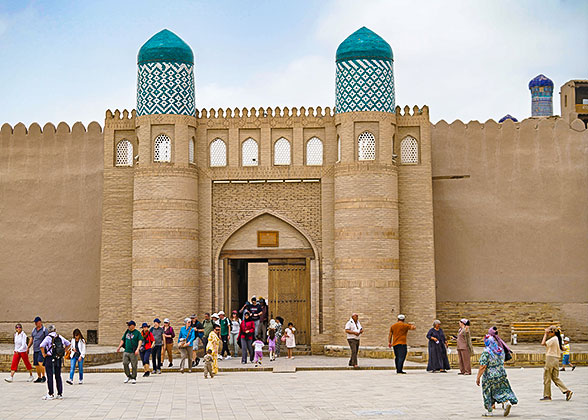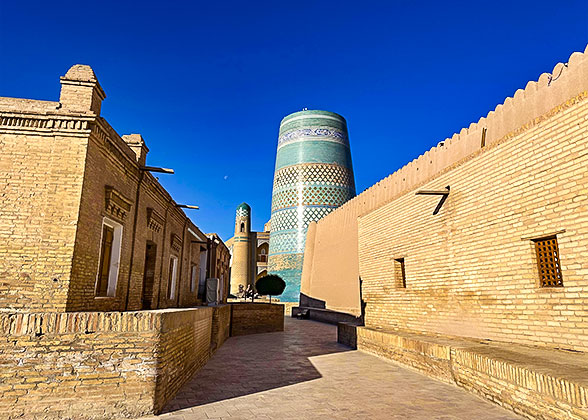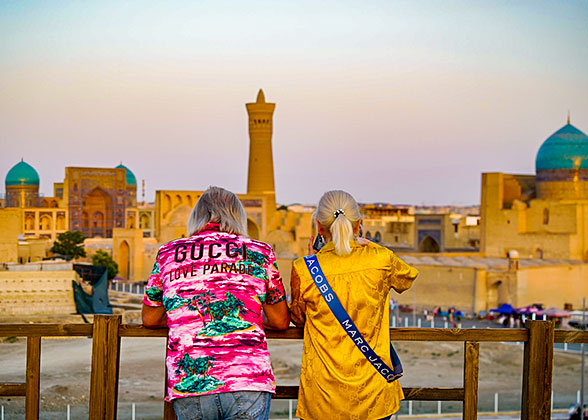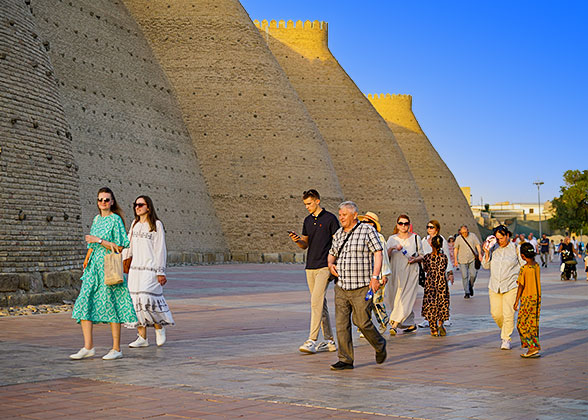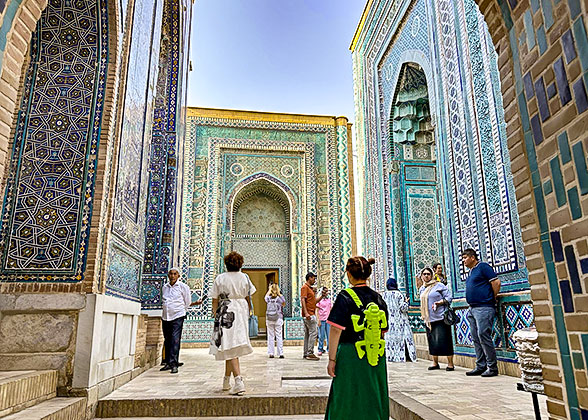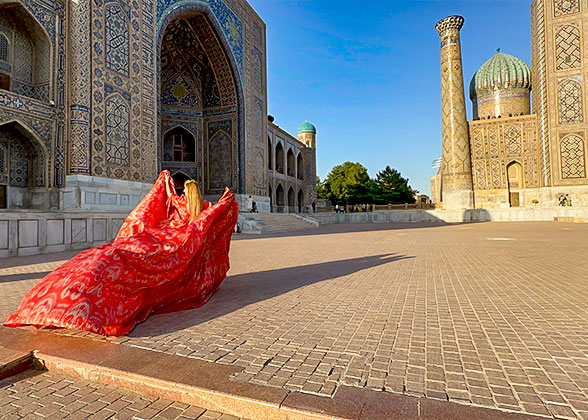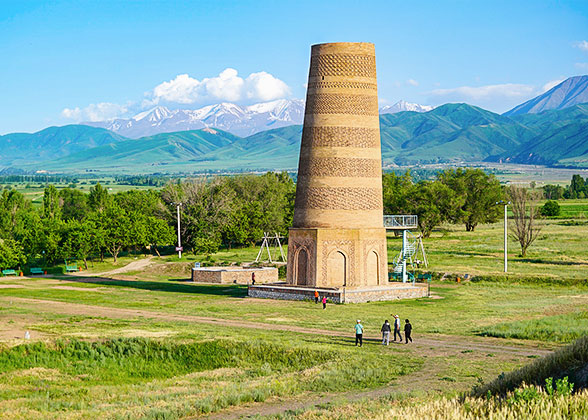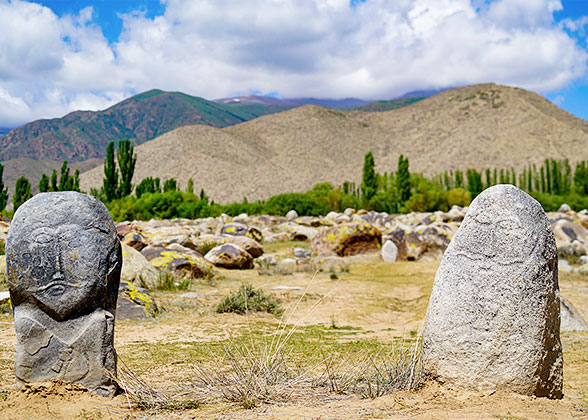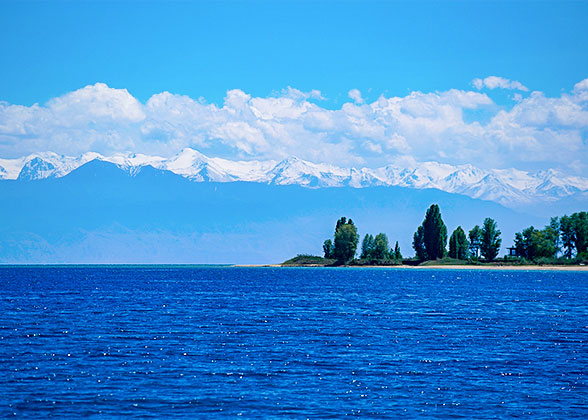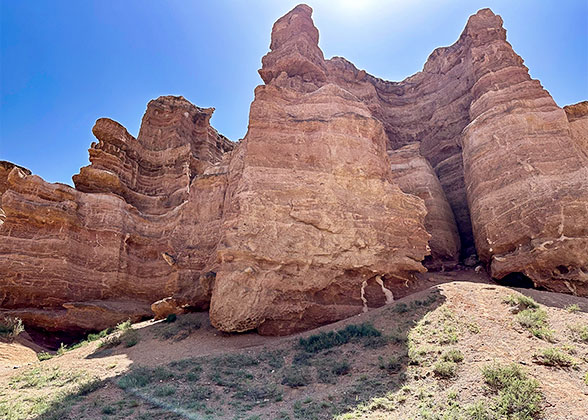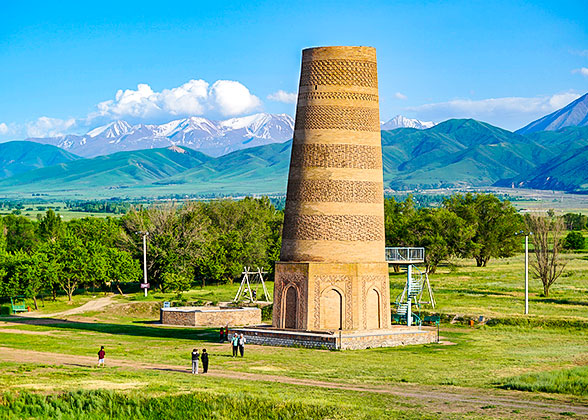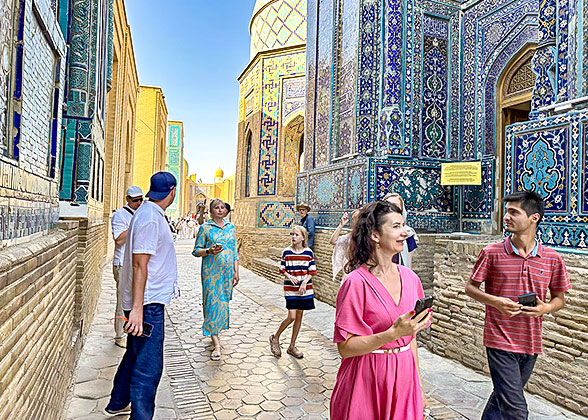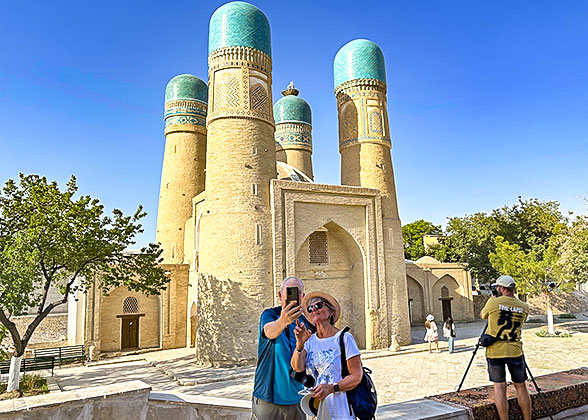Day 1: Tashkent Airport Pick-up, Visit Khast-Imam Complex, Chorsu Bazaar, State Museum of Applied Art
Khast-Imam Complex, Tashkent Welcome to the first destination of your Uzbekistan-Kyrgyzstan tour, Tashkent, the capital of Uzbekistan! As soon as you arrive at Tashkent Airport, our local driver will pick you up and transfer you to the hotel for check-in. As a pivotal Silk Road nexus, this city served as a knot connecting ancient China, the Turkic steppes, and Samarkand, and it was also a melting pot of different cultures, among which Islamic architecture is the most representative. After you recover from the jet lag, the guide with the driver will first accompany you to the paragon of Uzbekistan’s Islamic buildings, the Khast-Imam Complex. Let’s explore the spectacular buildings of the complex one by one! Standing at the edge of the square, you’ll first be immediately captivated by the symmetrical Barakh-khan Madrasah, featuring twin turquoise domes and honey-toned walls. Adjacent to the madrasah stands the Tilla Sheikh Mosque, where you can admire intricate Islamic calligraphy and floral motifs on its vaulted portal. On the northeast corner of the square, the Abubakr Kaffal-Shashi Mausoleum honors a revered 10th-century philosopher-poet and now is a pilgrimage site. The nearby Islamic Institute of Imam al-Bukhari thrives as one of Central Asia’s premier Islamic academies. Then, venture into the Chorsu Bazaar, where vibrant stalls are piled high with spices and handicrafts, showcasing the bustling daily Uzbek life. Listening to the hawking of the sellers and the bargaining of the customers, you may have a feeling of being in a caravan in ancient times. Crossing the bazaar, we will proceed to the State Museum of Applied Art, which houses over 7,000 Uzbek traditional artifacts from the 19th century to the present, such as polychrome ceramics, gold-embroidered textiles, intricate jewelry, and woodcarvings. In addition to various exhibits, the façade of the museum is a masterpiece of painted tilework and carved plaster. Afterward, descend underground to admire the Tashkent Metro, a relic of the Soviet Union era. With various decorations—crystal chandeliers, ornate ceramic panels, honeycombed ceilings, and polished marble columns, futuristic lighting—the stations are a treat, as some look like unique European palaces while others feature a strong sense of technology. We will take the subway to Independence Square and stroll to Amir Timur Square, where stands the equestrian statue of Timur, the founder of the Timurid Empire (1370-1507). The Tashkent sightseeing will be concluded at the poignant Earthquake Memorial built to commemorate lives lost in the 1966 Tashkent disaster.  Vanished Sogdian Legacy of Tashkent 2,000 years ago, Tashkent flourished as a Sogdian city-state. As ingenious merchants, the Sogdians were similar to the Jews in their diaspora networks. Successively dominated by Persian empires, Alexander the Great, Turkic Khaganates, Mongols, and Timurid forces, they blended with different ethnic groups, and their culture was gradually assimilated and replaced by Islamic monuments and Soviet edifices that we visit today.  Useful Information about Uzbekistan: 1. Visa Policy: Travelers from 50 countries, including the US, need to apply for an e-visa online 1-2 weeks ahead of time. The single-entry fee is USD 20. US citizens under 16 and over 55 can enter visa-free. The EU and 66 other countries, including the UK and Canada, are exempt from the visa requirement. 2. Currency: US dollars and euros are only accepted at some high-end hotels and restaurants, and Uzbek som (UZS) cash still dominates bazaars and small shops. ATMs are widely available in Tashkent, where you can withdraw som via Visa, Maestro cards, or US dollars. 3. Wear a Mask: Sensitive travelers are reminded to carry masks due to the desert dust and vehicle emissions in Uzbek cities. Accommodation: Wyndham Tashkent (4 stars) or similar
|
Day 2: Fly to Urgench, Drive to Khiva: Kunya-Ark, Kalta Minor Minaret, Juma Mosque
Our Tashkent driver will transfer you to the airport for a nearly 2-hour morning flight to Urgench. After landing, a local driver will pick you up and escort you to the hotel in Khiva. Tucked away on the border of Uzbekistan, Khiva has been writing its story since the 8th century, developing into a blossoming city of the Khwarezmian Empire (1077-1231). The intricate architecture and jade-green domes rise from the sand, looking like a mirage in the desert. Then, the private guide will accompany you to explore Ichan Kala. This is Khiva's impeccably preserved medieval inner city and Central Asia's inaugural UNESCO World Heritage site, which was inscribed in 1990. The tour will start at Kunya-Ark, the heart of the ancient city where rulers of Khiva once resided. Wandering through its rooms and halls adorned with dazzling tilework and vivid murals, just be amazed at the courtyard where royal decrees were declared and justice was administered. If interested, you can ascend its ramparts for panoramic views of the clay-brick cityscape merging with the surrounding desert. Southwest of the fortress, we’ll encounter two Islamic schools with dazzling portals, Muhammad Aminkhan Madrasah and Muhammad Rahim Khan Madrasah. In their neighborhood stands the 29-meter-high (95-foot) Kalta Minor Minaret. Although unfinished, it has hypnotic geometric patterns of cobalt, turquoise, and ivory tiles, which are very photogenic. Continuing eastward along winding alleys, we’ll reach the Juma Mosque. Open its crackling wooden door, and the mosque will welcome you with 218 uniquely carved wooden columns in the hall. Nearby, the Tosh-Hovli Palace features stone pillars draped in floral and geometric reliefs. Pass the turquoise dome of the Pakhlavan Makhmud Mausoleum, and conclude the Ichan Kala walking tour at the 57-meter-high (187-foot) Islam Khodja Minaret, which offers a parchment map-like cityscape as you climb its spiral staircases to the top. At dusk, there is also a chance to admire a magical sunset panorama. Meals: Breakfast Accommodation: Hotel Asia Khiva (4 stars) or similar
|
Day 3: Drive 7 Hours to Bukhara through Kyzylkum Desert
Today, our driver will escort you to traverse the Kyzylkum Desert to Bukhara, taking about 7-8 hours. Along the way, it’s possible to see patches of shrubs, such as saxaul trees and aromatic wormwood. Keeping alert, you may also witness desert foxes darting between dunes and herds of gazelles grazing on scrublands. If the visit time coincides with spring (March-June), the dunes will be transformed into carpets of wild tulips and poppies. Besides, you’ll encounter the Amu Darya River en route, which originates from the Pamirs Plateau and marks the Uzbekistan-Turkmenistan border. ► Tips: 1. Since there are few shops along the way, it is better to prepare boxed lunch and snacks on your own. 2. The road is unpaved and quite bumpy in the desert, so we remind you to take some Dramamine in case of car sickness. Besides, a headrest is helpful in alleviating discomfort. 3. Traveling in the desert may be dusty and baking, so masks and sun-protective gear are necessary. Upon arrival in Bukhara, you’ll be transferred to the selected hotel and have a good rest to recover from the fatigue of the car ride. As an ancient oasis with a 2,500-year history, Bukhara was once the capital of the Persian Samanid Empire in the 9th century. Later in 1220, it was conquered by Genghis Khan’s Mongol cavalry and ruled by Timur about 150 years later. As Central Asia’s best-preserved "open-air museum," it showcases over 170 medieval Islamic monuments recording centuries of architectural evolution.  Where to Fill Your Stomach (at your own expense): Want to reward yourself after the desert journey? Ayvan Restaurant is recommended. Housed in a restored 19th-century Jewish merchant’s residence, it is decorated with traditional Uzbek patterns. Just try its signature dish, grilled beef ribs, which are braised first and then roasted, boasting a crispy exterior yet tender and juicy interior. It is also a good idea to order salads to balance their richness. Besides that, you may also have a chance to catch an excellent piano performance in the evening. If you plan to dine here, please make a reservation ahead of time. Average Cost per Person: UZS 130,000-195,000 (USD 10-15). Credit cards are acceptable. Address: N. Husainova 7 Hotel Lyabi House, Bukhara, Uzbekistan. Meals: Breakfast Accommodation: Volida Hotel Bukhara (3 stars) or similar
|
Day 4: Bukhara: Chor-Minor Madrasah, Kalyan Minaret, Ark Fortress, Chashma Ayub Mausoleum
With our guide, your Bukhara walking tour will start at the city’s heart, Lyabi Hauz Ensemble, with two Islamic academies, a Sufi sanctuary, and the statue of the sage Hoja Nasruddin astride his donkey. Following the labyrinthine alleys, we will get to the oldest mosque in Central Asia, the Magoki-Attori Mosque, which now houses a carpet museum displaying exquisite Bukharan prayer rugs and Suzani embroideries. Then, continue to the photogenic Chor-Minor Madrasah, which once graced the cover of Lonely Planet Central Asia. Its four turquoise-crowned towers rise like chess pieces against the sky, each adorned with Islamic arabesques, Zoroastrian suns, Buddhist prayer wheels, and Christian crosses, respectively. Afterward, lose yourself in the Trade Domes Market to hunt for vibrant embroideries, traditional clothes, crockeries, and wooden carvings through an array of stalls. Near the market stand the grand Islamic scholarly legacies, Ulugh Beg Madrassah and Abdulaziz Khan Madrassah, shimmering with blue-tiled portals and delicate vaults adorned with hypnotic geometric patterns. The 47-meter-high (154-foot) Kalyan Minaret awaits your visit. Purportedly, in the 13th century, Genghis Khan razed all the buildings in Bukhara except this honey-hued structure, thanks to its grandeur. Its overshadowed neighbor, the Kalyan Mosque featuring a sea-green dome, now stands on its 8th-century foundation. After glimpsing the still-active Islamic school, Miri-Arab Madrassah, we will enter Ark Fortress, the rulers’ residence built in the 1st century in the northwest corner of Bukhara. Most of its vestiges run to the dust suffering wars, while some restored ones, such as the jail, mosque, and tower, still illustrate the lavish royal life. If interested, you can ascend the rampart to catch a panoramic view of the old city. Leaving the fortress, head to the Bolo Hauz Mosque to capture the reflection of its 20 carved wooden pillars in the octagonal pool and drop by one of the oldest brick structures in Central Asia, the Samanid Mausoleum. Our Bukhara sightseeing will end at the Chashma Ayub Mausoleum, where the Prophet Ayub allegedly found a healing spring. Beyond the tomb, there is a small museum demonstrating Bukhara’s ingenious water systems since the 10th century. Finally, the guide and the driver will escort you back to the hotel. Meals: Breakfast Accommodation: Volida Hotel Bukhara (3 stars) or similar Kalyan Minaret, Bukhara Ark Fortress
|
Day 5: Bukhara: Summer Palace, Chor-Bakr Necropolis; High-speed Train to Samarkand
Today’s first destination is the 19th-century Summer Palace (Sitorai Mohi Hosa). Integrating European and Central Asian architectural styles, the palace boasts chromatic glass windows and Persian miniature paintings. Its white palace at the lakeside was remodeled into a museum displaying royal robes and diplomatic gifts. Wandering through its garden, you may encounter peacocks preening their iridescent tails.
After that, make a pilgrimage to the holy site of Sufism, the Memorial Complex of Bahouddin Naqshband. In front of the saint’s tomb, you may see locals drawing "holy water" from the courtyard well, which is believed to carry blessings. Finally, head to the Chor-Bakr Necropolis, a classic Islamic complex built in the 16th century to commemorate the Djuybar Seyyids family, the descendants of Muhammad. If interested, you can ascend to the patio of its Islamic school to admire the sweeping view of the complex. Besides, there is an aviary at the entrance where you can see strutting peacocks, alert owls, and regal falcons.
Then, you’ll be escorted to the railway station for a 2-hour high-speed train to Samarkand. Upon arrival, our local driver will pick you up at the train station and transfer you to the handpicked hotel. Like Athens and Rome, Samarkand is one of the world’s oldest cities. Initially built in 650 BC, it was ruled by Alexander the Great in 329 BC, and devastated by Genghis Khan in the 13th century. Thanks to Timur, who rebuilt the city in the 14th century, Samarkand can appear as a “blue pearl” of the desert.
Meals: Breakfast
Accommodation: Grand Samarkand Superior (4 stars) or similar
|
Day 6: Samarkand: Registan Square, Shah-i-Zinda Necropolis; High-speed Train to Tashkent
Bibi-Khanym Mosque, Samarkand In the morning, our guide will accompany you to sightsee Samarkand’s highlights from the heart of the ancient city, Registan Square, where you’ll be staggered by spectacular portals, towering minarets, and blue domes of the three surrounding madrassahs (Islamic institutions). Then, pass through the crowded Siyob Bazaar, where you can see colorful fruits and vegetables piled in a pyramid shape, smell the aroma of spices, and hear the bargaining of customers. Near the bazaar, we will stop at the Bibi Khanym Mosque, the largest mosque of its kind in Uzbekistan, which is reportedly the inspiration for the Taj Mahal in India. Afterward, an 8-minute drive will lead you to the Ulugbek Observatory in the suburbs. Following the narrow staircases and descending underground, let’s see the remnant of the colossal quadrant, which was used to observe the coordinates of the stars. In the museum adjacent to the heritage, get a glimpse at a model of the original observatory and the 15th-century astronomical instruments. Then, hit the road to the Shah-i-Zinda Necropolis, the grandiose graves of Timur’s female family members, whose domes are like blue jewelry twinkling on the northeast slope of the hill. Walking along its avenue, you’ll be dazzled by the exquisite tilework on the portals and hypnotic vaults decorated with foliage and vine patterns. We will conclude the Samarkand tour at the Gur-Emir Mausoleum, paying homage to Timur, whose coffins lie under a blue vault resembling the sky. When the light streams from the framed windows, the stalactite-shaped decorations on the ceiling and portals will offer you a visual feast of light and shadow. After today's sightseeing, the driver will escort you to the train station for the high-speed train to Tashkent, taking about 2.5 hours. Upon arrival, your Tashkent driver will pick you up and transfer you to the hotel. Meals: Breakfast Accommodation: Wyndham Tashkent (4 stars) or similar Shah-i-Zinda Necropolis, Samarkand Gur-Emir Mausoleum, Samarkand
|
Day 7: Fly from Tashkent to Bishkek: Oak Park, Ala-Too Square, Old Square
The driver will escort you to the Tashkent airport in the morning, where you’ll board the plane to Bishkek, the capital of Kyrgyzstan. Dubbed the "Switzerland of Asia", Kyrgyzstan is a land of mountain ranges, sapphire lakes, and rolling grasslands, which is a sanctuary for nature lovers and photographers. As soon as you land, our Bishkek guide and the driver will transfer you to the hotel for check-in. After settling down, you’ll be accompanied to explore the city on foot. Bishkek unfolds as an emerald oasis framed by snow-peaked Tian Shan Mountains. However, influenced by the Soviet Union, it has a temperament that is quite similar to Tashkent, featuring buildings combining local and Soviet styles. For example, our first stop, the Abdylas Maldybayev National Opera and Ballet Theater, mirrors Moscow’s Bolshoi Theater with neoclassical white colonnades and honey-toned façades. Then, ramble in the shade of century-old oaks at the adjacent Soviet-style Oak Park and feel the pulse of the city in front of the spring and groups of statues. Following the paths, get to Ala-Too Square, where the equestrian statue of the Kyrgyz national hero, Manas, is watching his homeland. If lucky, you may see the guard swapping ceremony on the hour. Finally, we will stop at the Old Square and return to the hotel.  Essential Kyrgyzstan Travel Notes 1. Currency: Visa and Mastercard are accepted at most restaurants and shops, except local bazaars. You can exchange some Kyrgyz som (KGS) at local banks or ATMs with Visa or Mastercard, as most machines don’t accept American Express or Maestro cards. 2. Time Zone: Kyrgyzstan is 1 hour ahead of Uzbekistan, so please remember to adjust your watch upon arrival. Meals: Breakfast Accommodation: Ramada by Wyndham Bishkek Centre (4 stars) or similar
|
Day 8: Bishkek - Burana Tower - Cholpon Ata
In the morning, the guide will accompany you to the Burana Tower, part of the 10th-century capital ruins of the Karakhanid Khanate, the first Muslim Turkic regime from the 10th to the 13th centuries. The weathered minaret once soared 45 meters (147 feet), but it finally remained at 25 meters (82 feet) due to centuries of earthquakes. Despite this, it is a spot for couples to take wedding photos, with the steppes and Tian Shan Mountains as its backdrop. Ascending to its top, you can get a panoramic view of the surroundings. Please watch your step while climbing, since the staircases are dark and narrow. We will expand the exploration to the remaining castles, tombstones, three tombs, and the Turkic stone statues that were used to mark the graves nearby. Then, continue to cross the Chui Valley to Cholpon-Ata and stop at the Nomad Museum on the way to briefly learn about the traditional lifestyle of Kyrgyzstan by admiring saddles, yurts, ethnic costumes, and artifacts. In the afternoon, we will arrive at Cholpon-Ata, a resort since the Soviet era, on the north coast of Lake Issyk-Kul. After check-in, the rest of the day is free for your exploration. As the Earth’s second-largest alpine lake, Issyk-Kul will give you an illusion of being on the shore of the sea with its endless water surface and stretching golden sandy beaches. You can walk along the lake bank, feeling the water lapping under your feet, or sunbathe on the beach, relishing a tin of beer. Be sure to try various water sports such as swimming, jet skiing, parasailing, water scooters, or windsurfing in the summer (June-August).  Recommended Local Food: Beshbarmak Beshbarmak is a kind of lamb noodles, and is Kyrgyzstan’s national dish, always served at important festivals and ceremonies. The tender boiled noodles and succulent lamb are always dry-tossed with onions and garlic for a savory base. Alternatively, you can add some broth and eat it with fermented cheese balls. A bowl of Beshbarmak costs about KGS 200-300 (USD 2-3). Meals: Breakfast Accommodation: Kapriz Issyk Kul Resort (3 stars) or similar
|
Day 9: Visit the Museum of Petroglyphs; Drive 3h to Karakol
Before saying goodbye to Cholpon-Ata, you’ll be led to visit the open-air Museum of Petroglyphs, where carved boulders are scattered across grassy foothills. Listening to the guide’s explanation, you can decipher the ancient life of Kirghiz by touching inscriptions 4,000-2,000 years ago, which depict ibexes with crescent horns, and others reveal hunting scenes and chariot processions. Embark on a 3-hour drive, and we will arrive at Karakol, a small city located in the eastern part of Kyrgyzstan. The city preserves many Russian-style buildings, such as the Holy Trinity Cathedral. After the original cathedral was destroyed in an earthquake, the current wooden structure was rebuilt in 1895 without using any nails. Beneath its emerald roofs are blue-framed white walls incised with a golden niche and a chandelier. Nearby, the religious building Dungan Mosque will captivate you with its Chinese-style façade. In its courtyard stands a blue wooden minaret, and in its main hall, red pillars support its yellow roofs. Afterward, we will return to the hotel.  Recommended Local Food: Ashlyam-Fu Ashlyam-Fu is an iconic food of the local Dungan people. It is a kind of cold starch noodles often served with shredded omelette and radish, which looks like jelly and tastes chewy. Its cool and vinegary broth will bring a thrilling contrast to your taste buds. You can also add some garlic or chili oil to enrich the flavor. Meals: Breakfast Accommodation: Green Yard Hotel, Karakol (3 stars) or similar
|
Day 10: Explore Skazka Canyon & Bokonbayevo Village; Drive 5 Hours Back to Bishkek
In the morning, we will drive along the south shore of Lake Issyk-Kul to Skazka Canyon (Canyon Fairy Tale). Over millennia, wind and rain have chiseled a surreal world here. Exerting your imagination while rambling in sandstones, you’ll see castles, towers, and even cartoon characters. For a panoramic vista, you can climb up to the Low Viewpoint, where the canyon unfurls like a tapestry. Then, a 40-minute car ride will lead you to Bokonbayevo Village, which attracts numerous visitors from all over the world with its 4,000-year-old eagle-hunting tradition. Here, you’ll have a chance to take photos with a golden eagle standing on your arm. Since eagles need to molt from March to September, visiting from October to February will offer more chances to witness the hunting process. The raptor launches from the handler’s arm, swirls to spot prey, then dives swiftly, giving a lethal strike to the target. Every August, the village will hold a Birds of Prey Festival, during which you can not only watch golden eagles and falcons hunting, see intrepid hounds, and watch fierce archery contests, but also enjoy traditional folk song performances. If interested, we can arrange your trip to align with the time of the festival. Afterwards, we will drive 4-5 hours to return to Bishkek, where you’ll spend your last night in Kyrgyzstan. Meals: Breakfast Accommodation: Ramada by Wyndham Bishkek Centre (4 stars) or similar Lake Issyk-Kul Skazka Canyon
|
Day 11: Bishkek Airport See-off
Today, the guide and the driver will pick you up at the hotel and transfer you to the airport according to your schedule. Your Uzbekistan Kyrgyzstan tour ends here. Want to explore other countries along the Silk Road? We can continue to tailor the itinerary to Kazakhstan, Turkmenistan, Tajikistan, or the eastern starting point - China.
Meals: Breakfast
|

